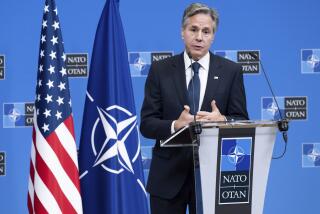PERSPECTIVE ON AMERICA’S ROLE IN THE WORLD : Will Peace Come With a Dawn? : Once again, a preoccupied Europe is slow to see the dangers, and its capacity to act lies paralyzed.
AACHEN, West Germany — There is no better place I know to reflect on the future of Europe than the marketplace in the city of Aachen, in front of the stately building where kings and emperors resided a thousand years ago when the Continent was still united.
Europe has had a fine summer. It seems as prosperous as ever, though with the weakness of the dollar, prices are often out of reach for the visitor. But this picture of peace and prosperity is a little deceptive.
Earlier this year it was much easier to feel optimistic about Europe’s future: East Europe had at long last become free, and 1992, that new milestone on the road to European unity, seemed just around the corner. Now, with the outbreak of the gulf crisis, the old weaknesses--the splits, the confusion, the essential impotence--have reappeared.
Many Europeans had persuaded themselves in recent years that a new age had dawned in which warplanes and tanks no longer counted, but only gross national product, productivity and, above all, foreign trade. True, this did not rule out that somewhere, in distant parts of the Third World, regional conflicts would recur. But however regrettable these conflicts, they were essentially irrelevant; world history would bypass Africa, Asia and also Latin America.
When Saddam Hussein occupied Kuwait, this was, of course, emphatically condemned in European capitals. But it was also frequently argued that to use violence against the aggressor would be even worse. For, in the final analysis, Iraq had to sell its oil, and the extra price to be paid would surely be less than the price of war. And what if Iraq intended to expand even further? This would be considered an inter-Arab affair; surely, sooner or later a counterforce would emerge in the Middle East. Hussein (like Gamal Abdel Nasser before him) might suddenly disappear from the scene; in any case, if action had to be taken, the United Nations was the obvious address.
All this is, of course, possible, but how likely is it? Unfortunately, it is equally possible that if aggression is not resisted, much of the Middle East will go up in flames. While welcome progress has been made, the United Nations is still invoked as an alibi; it is not yet an effective guardian of world peace. What many European politicians and policy-makers do not want to accept is the unfortunate fact that--the geopolitical and economic importance of the Middle East quite apart--the new age that has dawned promises to be much less peaceful than they have assumed.
Hussein has shown that tanks and airplanes are still of importance. More important yet, in this age of proliferating means of mass destruction, small aggressors have a power they never had before in history, unless one goes back to Genghis Khan, whose GNP was not very impressive either. Hussein happens to be the precursor; tomorrow there could be other such threats. And can it be excluded that one day in the more distant future, prosperous Europe, unable to defend itself, might be in the position of a super-Kuwait?
Fortunately, with the apparent end of the Cold War, a constellation has emerged that makes it possible--at least on the theoretical level--to provide effective resistance against nuclear and other blackmail. But the Soviet Union, facing a domestic crisis, is preoccupied with its internal affairs, China has no wish to collaborate, and Europe and Japan are reverting to their low-profile strategy.
It would be unfair to claim that this is the preferred strategy of all European policy-makers; many tend to take a more farsighted line. But it is still true that so many fail to see the danger that Europe’s capacity to act has again been paralyzed. They are angry with Saddam Hussein because he destroyed the new image of Europe as a “civilian superpower” and the belief in the unimportance of military strength. They are equally angry with the Americans who might do something about it.
The Cold War has ended, but America, in contrast to much of Europe, is still the only power trying to look beyond the present day, aware of the need for a new world order. Washington’s decision may be wrong on occasion, and U.S. power may not be sufficient to sustain its role as the guardian of world peace. But, in contrast to Europe (and the Soviet Union and Japan), it is at least trying to confront tomorrow’s dangers. The others are praying, like the proverbial peasant of old, that lightning will strike the neighbor’s house, not his own.
Twenty years ago, writing a history of Europe since World War II, my conclusions were optimistic: A Continent in ruins had recovered in every respect to an extent that seemed impossible in 1945. Seen in retrospect, the assessment was correct. But then the two oil shocks came, the European idea ran out of steam, a negative mood (“Europessimism”) prevailed. Rewriting my conclusions in 1980, I did not see much reason for optimism--the old Continent seemed to suffer from a paralysis of will.
But in the late 1980s, a new dynamism--a fresh, positive attitude--prevailed. Had I finished the third edition of the book in early 1990, it would have been only legitimate, in view of a cloudless political horizon, to end on a note of quiet confidence: At long last, Europe was coming into its own.
But I did not finish then--and how different everything looks today. It is too early to say that Europe has witnessed yet another false dawn, that the European Economic Community remains a fair-weather economic alliance and that true political union with the readiness to accept worldwide responsibilities remains a distant dream.
In a few months we shall know whether Europe is now capable of moving forward to a position of leadership in world affairs, or whether the old paralysis still persists. Until then one ought to suspend judgment.
More to Read
Sign up for Essential California
The most important California stories and recommendations in your inbox every morning.
You may occasionally receive promotional content from the Los Angeles Times.










